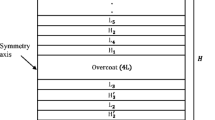Abstract
The development of computational tools for materials engineering requires physical phenomena that must be captured and integrated with various materials-related disciplines, and organization types. This integration discriminates between the materials development cycle and the product development cycle, and reduces the length of the materials development cycle from 10 years to 2 years. TFCalc software was used for optical designing .This article includes some mathematical models such as the spectral distribution of Si/SiO2 and Ge/SiO2 coatings transmittance.
Access this chapter
Tax calculation will be finalised at checkout
Purchases are for personal use only
Preview
Unable to display preview. Download preview PDF.
Similar content being viewed by others
References
[] G. Spanos, D.J. Rowenhorst, A.C. Lewis, and A. Geltmacher, MRS-Bulletin, 33 (2008), 597–602.
[] TFCalc Manual, Thin Film Design Software for Windows Version 3.0 (Software Spectra, Inc., Portland, Ore., 1995).
[] G.H. Rieke, “History of Infrared Telescope and Astronomy,” Experimental Astronomy, 25 (2009), 125–141.
[] G.C. Macfarlane, T.P. Mclean, J.E. Quarrington and V. Roberts, “Fine Structure in the Absorption-Edge Spectrum of Ge,” Physical Review, 108 (1957), 1377–1383.
[] R.M.A. Azzam, and N.M. Bennett, Ellipsometry and Polarized Light, North-Holland, Amsterdam, 1977.
[] H.B. Briggs, “Optical Effects in Bulk Silicon and Germanium,” Physical Review, 77 (1950), 287.
[] I.H. Malitson, “Interspecimen Comparison of the Refractive Index of Fused Silica,” Journal of the Optical Society of America, 55 (10) (1965), 1205.
[] W. Primak, “Refractive index of silicon,” Applied Optics, 10 (4) (1971), 759–763.
Author information
Authors and Affiliations
Editor information
Editors and Affiliations
Rights and permissions
Copyright information
© 2013 TMS (The Minerals, Metals & Materials Society)
About this chapter
Cite this chapter
Iqbal, K., Sha, J., Maqsood, A. (2013). Design Optimization of Transmission of Si/SiO2 and Ge/SiO2 Multilayer Coatings. In: Li, M., Campbell, C., Thornton, K., Holm, E., Gumbsch, P. (eds) Proceedings of the 2nd World Congress on Integrated Computational Materials Engineering (ICME). Springer, Cham. https://doi.org/10.1007/978-3-319-48194-4_14
Download citation
DOI: https://doi.org/10.1007/978-3-319-48194-4_14
Publisher Name: Springer, Cham
Print ISBN: 978-3-319-48585-0
Online ISBN: 978-3-319-48194-4
eBook Packages: Chemistry and Materials ScienceChemistry and Material Science (R0)




